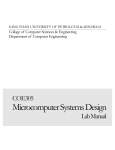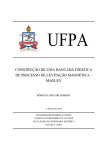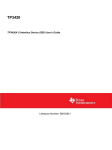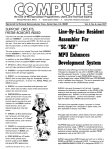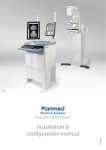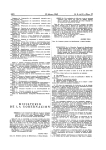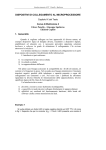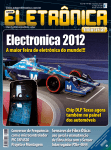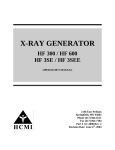Download Digital Audio Corporation MicroDAC IV Specifications
Transcript
DAC1006,DAC1007,DAC1008 DAC1006/DAC1007/DAC1008 P Compatible, Double-Buffered D to A Converters Literature Number: SNAS540 General Description The DAC1006/7/8 are advanced CMOS/Si-Cr 10-, 9- and 8-bit accurate multiplying DACs which are designed to interface directly with the 8080, 8048, 8085, Z-80 and other popular microprocessors. These DACs appear as a memory location or an I/O port to the µP and no interfacing logic is needed. These devices, combined with an external amplifier and voltage reference, can be used as standard D/A converters; and they are very attractive for multiplying applications (such as digitally controlled gain blocks) since their linearity error is essentially independent of the voltage reference. They become equally attractive in audio signal processing equipment as audio gain controls or as programmable attenuators which marry high quality audio signal processing to digitally based systems under microprocessor control. All of these DACs are double buffered. They can load all 10 bits or two 8-bit bytes and the data format is left justified. The analog section of these DACs is essentially the same as that of the DAC1020. The DAC1006 series are the 10-bit members of a family of microprocessor-compatible DAC’s (MICRO-DAC’s™). For applications requiring other resolutions, the DAC0830 series (8 bits) and the DAC1208 and DAC1230 (12 bits) are available alternatives. Part # Accuracy Pin Description (bits) DAC1006 10 DAC1007 9 DAC1008 8 Features n Uses easy to adjust END POINT specs, NOT BEST STRAIGHT LINE FIT n Low power consumption n Direct interface to all popular microprocessors n Integrated thin film on CMOS structure n Double-buffered, single-buffered or flow through digital data inputs n Loads two 8-bit bytes or a single 10-bit word n Logic inputs which meet TTL voltage level specs (1.4V logic threshold) n Works with ± 10V reference — full 4-quadrant multiplication n Operates STAND ALONE (without µP) if desired n Available in 0.3" standard 20-pin package n Differential non-linearity selection available as special order Key Specifications n n n n n n Output Current Settling Time: 500 ns Resolution: 10 bits Linearity: 10, 9, and 8 bits (guaranteed over temp.) Gain Tempco: −0.0003% of FS/˚C Low Power Dissipation: 20 mW (including ladder) Single Power Supply: 5 to 15 VDC For left20 justified data Typical Application DAC1006/1007/1008 DAC1006/DAC1007/DAC1008 DAC1006/DAC1007/DAC1008 µP Compatible, Double-Buffered D to A Converters DAC1006/DAC1007/DAC1008 µP Compatible, Double-Buffered D to A Converters April 1998 DS005688-1 *NOTE: FOR DETAILS OF BUS CONNECTION SEE SECTION 6.0 MICRO-DAC™ and BI-FET™ are trademarks of National Semiconductor Corp. © 1998 National Semiconductor Corporation DS005688 PrintDate=1998/11/17 PrintTime=11:38:07 46711 ds005688 Rev. No. 4 www.national.com cmserv Proof 1 1 Absolute Maximum Ratings (Notes 1, 2) ESD Susceptibility (Note 11) Lead Temp. (Soldering, 10 seconds) Dual-In-Line Package (plastic) Dual-In-Line Package (ceramic) If Military/Aerospace specified devices are required, please contact the National Semiconductor Sales Office/ Distributors for availability and specifications. Supply Voltage (VCC) Voltage at Any Digital Input Voltage at VREF Input Storage Temperature Range Package Dissipation at TA = 25˚C (Note 3) DC Voltage Applied to IOUT1 or IOUT2 (Note 4) 17 VDC VCC to GND ± 25V −65˚C to +150˚C Operating Ratings 800V 260˚C 300˚C (Note 1) TMIN ≤ TA ≤ TMAX Temperature Range Part numbers with “LCN” and “LCWN” suffix Voltage at Any Digital Input 500 mW 0˚C to 70˚C VCC to GND −100 mV to VCC Electrical Characteristics Tested at VCC = 4.75 VDC and 15.75 VDC, TA = 25˚C, VREF = 10.000 VDC unless otherwise noted Parameter Conditions VCC = 12VDC ± 5% See Note Min. Typ. Resolution Linearity Error Differential Nonlinearity Monotonicity Min. Typ. Max. 10 bits DAC1006 0.05 0.05 % of FSR DAC1007 0.1 0.1 % of FSR DAC1008 0.2 0.2 % of FSR DAC1006 0.1 0.1 % of FSR DAC1007 0.2 0.2 % of FSR DAC1008 0.4 0.4 % of FSR 4,7 TMIN < TA < TMAX 6 −10V≤VREF≤+10V 5 Endpoint adjust only 4,7 TMIN < TA < TMAX 6 −10V≤VREF≤+10V 5 TMIN < TA < TMAX 4,6 5 DAC1006 10 10 bits DAC1007 9 9 bits DAC1008 8 8 bits Gain Error Using internal Rfb −10V≤VREF≤+10V 5 Gain Error Tempco TMIN < TA < TMAX 6 Using internal Rfb 9 Rejection Units Max. 10 Endpoint adjust only −10V≤VREF≤+10V Power Supply VCC = 5VDC ± 5% to 15VDC ± 5% ± 0.3 1.0 −0.0003 −0.001 VCC = 14.5V to 15.5V 0.003 0.008 11.5V to 12.5V 0.004 0.010 −1.0 −1.0 ± 0.3 1.0 % of FS −0.0006 −0.002 % of FS/˚C All digital inputs latched high % FSR/V % FSR/V 4.75V to 5.25V 0.033 0.10 % FSR/V 15 20 kΩ Reference Input Resistance Output Feedthrough Error 10 15 20 10 VREF = 20Vp-p, f = 100 kHz All data inputs 90 90 mVp-p latched low www.national.com 2 PrintDate=1998/11/17 PrintTime=11:38:07 46711 ds005688 Rev. No. 4 cmserv Proof 2 Electrical Characteristics (Continued) = 4.75 VDC and 15.75 VDC, TA = 25˚C, VREF = 10.000 VDC unless otherwise noted Tested at VCC Parameter Conditions VCC = 12VDC ± 5% See Note Min. Output IOUT1 Capacitance IOUT2 All data inputs latched low Typ. Min. Typ. Max. 60 60 pF 250 250 pF All data inputs 250 250 pF IOUT2 latched high 60 60 pF Output Leakage TMIN≤TA≤TMAX 6 TMIN≤TA≤TMAX 6 IOUT1 All data inputs IOUT2 All data inputs latched low 0.5 10 latched high TMIN≤TA≤TMAX Digital Input Voltages 3.5 0.5 3.5 mA 200 200 nA 200 200 nA 0.7, 0.8 VDC 6 Low level LCN and LCWM suffix 0.8, 0.8 High level (all parts) TMIN≤TA≤TMAX Digital Input Currents Current Units Max. IOUT1 Supply Current Drain Current VCC = 5VDC ± 5% to 15VDC ± 5% tS 2.0 2.0 VDC 6 Digital inputs < 0.8V −40 −150 −40 −150 µADC Digital inputs > 2.0V VIL = 0V, VIH = 5V 1.0 +10 1.0 +10 µADC 500 500 ns Settling Time Write and tW XFER Pulse Width Data Set Up tDS Time Data Hold tDH tCS Time tCH 8 150 60 320 200 ns 9 320 100 500 250 ns 9 TMIN≤TA≤TMAX VIL = OV, VIH = 5V 9 TMIN≤TA≤TMAX VIL = 0V, VIL = 5V, TA = 25˚C Up Time Control Hold TMIN≤TA≤TMAX VIL = 0V, VIH = 5V, TA = 25˚C TA = 25˚C Time Control Set VIL = 0V, VIH = 5V, TA = 25˚C 9 TMIN≤TA≤TMAX VIL = 0V, VIH = 5V, TA = 25˚C TMIN≤TA≤TMAX 9 150 80 320 170 ns 320 120 500 250 ns 200 100 320 220 ns 250 120 500 320 ns 150 60 320 180 ns 320 100 500 260 ns 10 0 10 0 ns 10 0 10 0 ns Note 1: Absolute Maximum Ratings indicate limits beyond which damage to the device may occur. DC and AC electrical specifications do not apply when operating the device beyond its specified operating conditions. Note 2: All voltages are measured with respect to GND, unless otherwise specified. Note 3: This 500 mW specification applies for all packages. The low intrinsic power dissipation of this part (and the fact that there is no way to significantly modify the power dissipation) removes concern for heat sinking. Note 4: For current switching applications, both IOUT1 and IOUT2 must go to ground or the “Virtual Ground” of an operational amplifier. The linearity error is degraded by approximately VOS÷VREF. For example, if VREF = 10V then a 1 mV offset, VOS, on IOUT1 or IOUT2 will introduce an additional 0.01% linearity error. Note 5: Guaranteed at VREF = ± 10 VDC and VREF = ± 1 VDC. Note 6: TMIN = 0˚C and TMAX = 70˚C for “LCN” and “LCWM” suffix parts. Note 7: The unit “FSR” stands for “Full Scale Range.” “Linearity Error” and “Power Supply Rejection” specs are based on this unit to eliminate dependence on a particular VREF value and to indicate the true performance of the part. The “Linearity Error” specification of the DAC1006 is “0.05% of FSR (MAX).” This guarantees that after performing a zero and full scale adjustment (See Sections 2.5 and 2.6), the plot of the 1024 analog voltage outputs will each be within 0.05%xVREF of a straight line which passes through zero and full scale. Note 8: This specification implies that all parts are guaranteed to operate with a write pulse or transfer pulse width (tW) of 320 ns. A typical part will operate with tW of only 100 ns. The entire write pulse must occur within the valid data interval for the specified tW, tDS, tDH, and tS to apply. Note 9: Guaranteed by design but not tested. 3 PrintDate=1998/11/17 PrintTime=11:38:08 46711 ds005688 Rev. No. 4 www.national.com cmserv Proof 3 Electrical Characteristics (Continued) Note 10: A 200 nA leakage current with Rfb = 20K and VREF = 10V corresponds to a zero error of (200x10−9x20x103)x100÷ 10 which is 0.04% of FS. Note 11: Human body model, 100 pF discharged through a 1.5 kΩ resistor. Switching Waveforms DS005688-2 www.national.com 4 PrintDate=1998/11/17 PrintTime=11:38:08 46711 ds005688 Rev. No. 4 cmserv Proof 4 Typical Performance Characteristics Errors vs. Supply Voltage Write Width, tw Errors vs. Temperature DS005688-31 DS005688-30 DS005688-29 Control Setup Time, tCS Data Setup Time, tDS DS005688-32 Data Hold Time, tDH DS005688-34 DS005688-33 Digital Threshold vs. Supply Voltage Digital Input Threshold vs. Temperature DS005688-35 DS005688-36 5 PrintDate=1998/11/17 PrintTime=11:38:08 46711 ds005688 Rev. No. 4 www.national.com cmserv Proof 5 Block and Connection Diagrams DAC1006/1007/1008 (20-Pin Parts) DS005688-5 Use DAC1006/1007/1008 for left justified data. DAC1006/1007/1008 (20-Pin Parts) Dual-In-Line Package DS005688-28 Top View See Ordering Information www.national.com 6 PrintDate=1998/11/17 PrintTime=11:38:08 46711 ds005688 Rev. No. 4 cmserv Proof 6 DAC1006/1007/1008 — Simple Hookup for a “Quick Look” DS005688-7 *A TOTAL OF 10 INPUT SWITCHES & 1K RESISTORS Notes: 1. For VREF = −10.240 VDC the output voltage steps are approximately 10 mV each. 2. SW1 is a normally closed switch. While SW1 is closed, the DAC register is latched and new data can be loaded into the input latch via the 10 SW2 switches. When SW1 is momentarily opened the new data is transferred from the input latch to the DAC register and is latched when SW1 again closes. amp is used to provide an output voltage for the DAC. This on-chip resistor should always be used (not an external resistor) because it matches the resistors used in the on-chip R-2R ladder and tracks these resistors over temperature. VREF: Reference Voltage Input — This is the connection for the external precision voltage source which drives the R-2R ladder. VREF can range from −10 to +10 volts. This is also the analog voltage input for a 4-quadrant multiplying DAC application. VCC: Digital Supply Voltage — This is the power supply pin for the part. VCC can be from +5 to +15 VDC. Operation is optimum for +15V. The input threshold voltages are nearly independent of VCC. (See Typical Performance Characteristics and Description in Section 3.0, T2L compatible logic inputs.) GND: Ground — the ground pin for the part. 1.3 Definition of Terms Resolution: Resolution is directly related to the number of switches or bits within the DAC. For example, the DAC1006 has 210 or 1024 steps and therefore has 10-bit resolution. Linearity Error: Linearity error is the maximum deviation from a straight line passing through the endpoints of the DAC transfer characteristic. It is measured after adjusting for zero and full-scale. Linearity error is a parameter intrinsic to the device and cannot be externally adjusted. National’s linearity test (a) and the “best straight line” test (b) used by other suppliers are illustrated below. The “best straight line” requires a special zero and FS adjustment for each part, which is almost impossible for user to determine. The “end point test” uses a standard zero and FS adjustment procedure and is a much more stringent test for DAC linearity. Power Supply Sensitivity: Power supply sensitivity is a measure of the effect of power supply changes on the DAC full-scale output (which is the worst case). 1.0 DEFINITION OF PACKAGE PINOUTS 1.1 Control Signals (All control signals are level actuated.) CS: Chip Select — active low, it will enable WR. WR: Write — The active low WR is used to load the digital data bits (DI) into the input latch. The data in the input latch is latched when WR is high. The 10-bit input latch is split into two latches; one holds 8 bits and the other holds 2 bits. The Byte1/Byte2 control pin is used to select both input latches when Byte1/Byte2 = 1 or to overwrite the 2-bit input latch when in the low state. Byte1/Byte2: Byte Sequence Control — When this control is high, all ten locations of the input latch are enabled. When low, only two locations of the input latch are enabled and these two locations are overwritten on the second byte write. On the DAC1006, 1007, and 1008, the Byte1/Byte2 must be low to transfer the 10-bit data in the input latch to the DAC register. XFER: Transfer Control Signal, active low — This signal, in combination with others, is used to transfer the 10-bit data which is available in the input latch to the DAC register — see timing diagrams. 1.2 Other Pin Functions DIi (i = 0 to 9): Digital Inputs — DI0 is the least significant bit (LSB) and DIg is the most significant bit (MSB). IOUT1: DAC Current Output 1 — IOUT1 is a maximum for a digital input code of all 1s and is zero for a digital input code of all 0s. IOUT2: DAC Current Output 2 — IOUT2 is a constant minus IOUT1, or where R ≅ 15 kΩ. RFB: Feedback Resistor — This is provided on the IC chip for use as the shunt feedback resistor when an external op 7 PrintDate=1998/11/17 PrintTime=11:38:08 46711 ds005688 Rev. No. 4 www.national.com cmserv Proof 7 DAC1006/1007/1008 — Simple Hookup for a “Quick Look” a. End Point Test After Zero and FS Adj. (Continued) b. Best Straight Line DS005688-37 DS005688-38 3.0 TTL COMPATIBLE LOGIC INPUTS Settling Time: Settling time is the time required from a code transition until the DAC output reaches within ± 1⁄2 LSB of the final output value. Full-scale settling time requires a zero to full-scale or full-scale to zero output change. Full-Scale Error: Full scale error is a measure of the output error between an ideal DAC and the actual device output. Ideally, for the DAC1006 series, full-scale is VREF−1 LSB. For VREF = −10V and unipolar operation, VFULL-SCALE = 10.0000V −9.8mV = 9.9902V. Full-scale error is adjustable to zero. Monotonicity: If the output of a DAC increases for increasing digital input code, then the DAC is monotonic. A 10-bit DAC with 10-bit monotonicity will produce an increasing analog output when all 10 digital inputs are exercised. A 10-bit DAC with 9-bit monotonicity will be monotonic when only the most significant 9 bits are exercised. Similarly, 8-bit monotonicity is guaranteed when only the most significant 8 bits are exercised. To guarantee TTL voltage compatibility of the logic inputs, a novel bipolar (NPN) regulator circuit is used. This makes the input logic thresholds equal to the forward drop of two diodes (and also matches the temperature variation) as occurs naturally in TTL. The basic circuit is shown in Figure 1. A curve of digital input threshold as a function of power supply voltage is shown in the Typical Performance Characteristics section. 4.0 APPLICATION HINTS The DC stability of the VREF source is the most important factor to maintain accuracy of the DAC over time and temperature changes. A good single point ground for the analog signals is next in importance. These MICRO-DAC converters are CMOS products and reasonable care should be exercised in handling them prior to final mounting on a PC board. The digital inputs are protected, but permanent damage may occur if the part is subjected to high electrostatic fields. Store unused parts in conductive foam or anti-static rails. 2.0 DOUBLE BUFFERING These DACs are double-buffered, microprocessor compatible versions of the DAC1020 10-bit multiplying DAC. The addition of the buffers for the digital input data not only allows for storage of this data, but also provides a way to assemble the 10-bit input data word from two write cycles when using an 8-bit data bus. Thus, the next data update for the DAC output can be made with the complete new set of 10-bit data. Further, the double buffering allows many DACs in a system to store current data and also the next data. The updating of the new data for each DAC is also not time critical. When all DACs are updated, a common strobe signal can then be used to cause all DACs to switch to their new analog output levels. www.national.com 4.1 Power Supply Sequencing & Decoupling Some IC amplifiers draw excessive current from the Analog inputs to V− when the supplies are first turned on. To prevent damage to the DAC — an external Schottky diode connected from IOUT1 or IOUT2 to ground may be required to prevent destructive currents in IOUT1 or IOUT2. If an LM741 or LF356 is used — these diodes are not required. The standard power supply decoupling capacitors which are used for the op amp are adequate for the DAC. 8 PrintDate=1998/11/17 PrintTime=11:38:08 46711 ds005688 Rev. No. 4 cmserv Proof 8 DAC1006/1007/1008 — Simple Hookup for a “Quick Look” (Continued) DS005688-9 FIGURE 1. Basic Logic Threshold Loop der current to the IOUT1 output pin. These MOS switches operate in the current mode with a small voltage drop across them and can therefore switch currents of either polarity. This is the basis for the 4-quadrant multiplying feature of this DAC. 4.2 Op Amp Bias Current & Input Leads The op amp bias current (IB) CAN CAUSE DC ERRORS. BI-FET™ op amps have very low bias current, and therefore the error introduced is negligible. BI-FET op amps are strongly recommended for these DACs. The distance from the IOUT1 pin of the DAC to the inverting input of the op amp should be kept as short as possible to prevent inadvertent noise pickup. 5.1.1 Providing a Unipolar Output Voltage with the DAC in the Current Switching Mode A voltage output is provided by making use of an external op amp as a current-to-voltage converter. The idea is to use the internal feedback resistor, RFB, from the output of the op amp to the inverting (−) input. Now, when current is entered at this inverting input, the feedback action of the op amp keeps that input at ground potential. This causes the applied input current to be diverted to the feedback resistor. The output voltage of the op amp is forced to a voltage given by: VOUT = −(IOUT1xRFB) 5.0 ANALOG APPLICATIONS The analog section of these DACs uses an R-2R ladder which can be operated both in the current switching mode and in the voltage switching mode. The major product changes (compared with the DAC1020) have been made in the digital functioning of the DAC. The analog functioning is reviewed here for completeness. For additional analog applications, such as multipliers, attenuators, digitally controlled amplifiers and low frequency sine wave oscillators, refer to the DAC1020 data sheet. Some basic circuit ideas are presented in this section in addition to complete applications circuits. Notice that the sign of the output voltage depends on the direction of current flow through the feedback resistor. In current switching mode applications, both current output pins (IOUT1 and IOUT2) should be operated at 0 VDC. This is accomplished as shown in Figure 3. The capacitor, CC, is used to compensate for the output capacitance of the DAC and the input capacitance of the op amp. The required feedback resistor, RFB, is available on the chip (one end is internally tied to IOUT1) and must be used since an external resistor will not provide the needed matching and temperature tracking. This circuit can therefore be simplified as shown in Figure 4, where the sign of the reference voltage has been changed to provide a positive output voltage. Note that the output current, IOUT1, now flows through the RFB pin. 5.1 Operation in Current Switching Mode The analog circuitry, Figure 2, consists of a silicon-chromium (Si-Cr) thin film R-2R ladder which is deposited on the surface oxide of the monolithic chip. As a result, there is no parasitic diode connected to the VREF pin as would exist if diffused resistors were used. The reference voltage input (VREF) can therefore range from −10V to +10V. The digital input code to the DAC simply controls the position of the SPDT current switches, SW0 to SW9. A logical 1 digital input causes the current switch to steer the available lad- 9 PrintDate=1998/11/17 PrintTime=11:38:09 46711 ds005688 Rev. No. 4 www.national.com cmserv Proof 9 DAC1006/1007/1008 — Simple Hookup for a “Quick Look” (Continued) DIGITAL INPUT CODE DS005688-39 FIGURE 2. Current Mode Switching DS005688-40 OP AMP CC pF Rj ts µS LF356 22 24 ∞ ∞ 3 LF351 LF357 10 2.4k 1.5 4 FIGURE 3. Converting IOUT to VOUT (−512≤D≤+511 or 1000000000≤D≤0111111111). If the applied digital input is interpreted as the decimal equivalent of a true binary word, VOUT can be found by: 5.1.2 Providing a Bipolar Output Voltage with the DAC in the Current Switching Mode The addition of a second op amp to the circuit of Figure 4 can be used to generate a bipolar output voltage from a fixed reference voltage Figure 5. This, in effect, gives sign significance to the MSB of the digital input word to allow two quadrant multiplication of the reference voltage. The polarity of the reference can also be reversed to realize the full four-quadrant multiplication. The applied digital word is offset binary which includes a code to output zero volts without the need of a large valued resistor common to existing bipolar multiplying DAC circuits. Offset binary code can be derived from 2’s complement data (most common for signed processor arithmetic) by inverting the state of the MSB in either software or hardware. After doing this the output then responds in accordance to the following expression: With this configuration, only the offset voltage of amplifier 1 need be nulled to preserve linearity of the DAC. The offset voltage error of the second op amp has no effect on linearity. It presents a constant output voltage error and should be nulled only if absolute accuracy is needed. Another advantage of this configuration is that the values of the external resistors required do not have to match the value of the internal DAC resistors; they need only to match and temperature track each other. A thin film 4 resistor network available from Beckman Instruments, Inc. (part no. 694-3-R10K-D) is ideally suited for this application. Two of the four available 10 kΩ resistor can be paralleled to form R in Figure 5 and the other two can be used separately as the resistors labeled 2R. where VREF can be positive or negative and D is the signed decimal equivalent of the 2’s complement processor data. www.national.com 10 PrintDate=1998/11/17 PrintTime=11:38:09 46711 ds005688 Rev. No. 4 cmserv Proof 10 DAC1006/1007/1008 — Simple Hookup for a “Quick Look” (Continued) Operation is summarized in the table below: Applied 2’s Comp. 2’s Comp. Applied True Binary (Decimal) (Binary) Digital Input (Decimal) +VREF −VREF 0111111111 1111111111 1023 VREF−1 LSB −|VREF|+1 LSB −|VREF|/2 +511 VOUT +256 0100000000 1100000000 768 VREF/2 0 0000000000 1000000000 512 0 0 −1 1111111111 0111111111 511 −1 LSB +1 LSB −256 1100000000 0100000000 256 −VREF/2 +|VREF|/2 −512 1000000000 0000000000 0 −VREF +|VREF| DS005688-41 FIGURE 4. Providing a Unipolar Output Voltage DS005688-42 FIGURE 5. Providing a Bipolar Output Voltage with the DAC in the Current Switching Mode single op amp as shown in Figure 10. For a digital input code of all zeros, the output voltage from the VREF pin is zero volts. The external op amp now has a single input of +V and is operating with a gain of −1 to this input. The output of the op amp therefore will be at −V for a digital input of all zeros. As the digital code increases, the output voltage at the VREF pin increases. Notice that the gain of the op amp to voltages which are applied to the (+) input is +2 and the gain to voltages which are applied to the input resistor, R, is −1. The output voltage of the op amp depends on both of these inputs and is given by: VOUT = (+V) (−1)+VREF(+2) 5.2 Analog Operation in the Voltage Switching Mode Some useful application circuits result if the R-2R ladder is operated in the voltage switching mode. There are two very important things to remember when using the DAC in the voltage mode. The reference voltage (+V) must always be positive since there are parasitic diodes to ground on the IOUT1 pin which would turn on if the reference voltage went negative. To maintain a degradation of linearity less than ± 0.005%, keep +V ≤ 3 VDC and VCC at least 10V more positive than +V. Figures 6, 7 show these errors for the voltage switching mode. This operation appears unusual, since a reference voltage (+V) is applied to the IOUT1 pin and the voltage output is the VREF pin. This basic idea is shown in Figure 8. This VOUT range can be scaled by use of a non-inverting gain stage as shown in Figure 9. Notice that this is unipolar operation since all voltages are positive. A bipolar output voltage can be obtained by using a 11 PrintDate=1998/11/17 PrintTime=11:38:09 46711 ds005688 Rev. No. 4 www.national.com cmserv Proof 11 DAC1006/1007/1008 — Simple Hookup for a “Quick Look” (Continued) DS005688-43 DS005688-44 FIGURE 6. FIGURE 7. DIGITAL INPUT CODE DS005688-45 FIGURE 8. Voltage Mode Switching DS005688-46 FIGURE 9. Amplifying the Voltage Mode Output (Single Supply Operation) DS005688-47 FIGURE 10. Providing a Bipolar Output Voltage with a Single Op Amp www.national.com 12 PrintDate=1998/11/17 PrintTime=11:38:09 46711 ds005688 Rev. No. 4 cmserv Proof 12 DAC1006/1007/1008 — Simple Hookup for a “Quick Look” (Continued) DS005688-48 FIGURE 11. Increasing the Output Voltage Swing 5.4.1 Current Switching with Unipolar Output Voltage After doing a “zero adjust,” set all of the digital input levels HIGH and adjust the magnitude of VREF for The output voltage swing can be expanded by adding 2 resistors to Figure 10 as shown in Figure 11. These added resistors are used to attenuate the +V voltage. The overall gain, AV(−), from the +V terminal to the output of the op amp determines the most negative output voltage, −4(+V) (when the VREF voltage at the + input of the op amp is zero) with the component values shown. The complete dynamic range of VOUT is provided by the gain from the (+) input of the op amp. As the voltage at the VREF pin ranges from 0V to +V(1023/1024) the output of the op amp will range from −10 VDC to +10V (1023/1024) when using a +V voltage of +2.500 VDC. The 2.5 VDC reference voltage can be easily developed by using the LM336 zener which can be biased through the RFB internal resistor, connected to VCC. This completes the DAC calibration. 5.4.2 Current Switching with Bipolar Output Voltage The circuit of Figure 12 shows the 3 adjustments needed. The first step is to set all of the digital inputs LOW (to force IOUT1 to 0) and then trim “zero adj.” for zero volts at the inverting input (pin 2) of 0A1. Next, with a code of all zeros still applied, adjust “−FS adj.”, the reference voltage, for VOUT = ± |(ideal VREF)|. The sign of the output voltage will be opposite that of the applied reference. Finally, set all of the digital inputs HIGH and adjust “+FS adj.” for VOUT = VREF (511/512). The sign of the output at this time will be the same as that of the reference voltage. The addition of the 200Ω resistor in series with the VREF pin of the DAC is to force the circuit gain error from the DAC to be negative. This insures that adding resistance to Rfb, with the 500Ω pot, will always compensate the gain error of the DAC. 5.3 Op Amp VOS Adjust (Zero Adjust) for Current Switching Mode Proper operation of the ladder requires that all of the 2R legs always go to exactly 0 VDC (ground). Therefore offset voltage, VOS, of the external op amp cannot be tolerated as every millivolt of VOS will introduce 0.01% of added linearity error. At first this seems unusually sensitive, until it becomes clear the 1 mV is 0.01% of the 10V reference! High resolution converters of high accuracy require attention to every detail in an application to achieve the available performance which is inherent in the part. To prevent this source of error, the VOS of the op amp has to be initially zeroed. This is the “zero adjust” of the DAC calibration sequence and should be done first. If the VOS is to be adjusted there are a few points to consider. Note that no “dc balancing” resistance should be used in the grounded positive input lead of the op amp. This resistance and the input current of the op amp can also create errors. The low input biasing current of the BI-FET op amps makes them ideal for use in DAC current to voltage applications. The VOS of the op amp should be adjusted with a digital input of all zeros to force IOUT = 0 mA. A 1 kΩ resistor can be temporarily connected from the inverting input to ground to provide a dc gain of approximately 15 to the VOS of the op amp and make the zeroing easier to sense. 5.4.3 Voltage Switching with a Unipolar Output Voltage Refer to the circuit of Figure 13 and set all digital inputs LOW. Trim the “zero adj.” for VOUT = 0 VDC ± 1 mV. Then set all digital inputs HIGH and trim the “FS Adj.” for: 5.4.4 Voltage Switching with a Bipolar Output Voltage Refer to Figure 14 and set all digital inputs LOW. Trim the “−FS Adj.” for VOUT = −2.5 VDC. Then set all digital inputs HIGH and trim the “+FS Adj.” for VOUT = +2.5 (511/512) VDC. Test the zero by setting the MS digital input HIGH and all the rest LOW. Adjust VOS of amp #3, if necessary, and recheck the full-scale values. 5.4 Full-Scale Adjust The full-scale adjust procedure depends on the application circuit and whether the DAC is operated in the current switching mode or in the voltage switching mode. Techniques are given below for all of the possible application circuits. 13 PrintDate=1998/11/17 PrintTime=11:38:09 46711 ds005688 Rev. No. 4 www.national.com cmserv Proof 13 DAC1006/1007/1008 — Simple Hookup for a “Quick Look” (Continued) DS005688-49 FIGURE 12. Full Scale Adjust — Current Switching with Bipolar Output Voltage DS005688-50 FIGURE 13. Full Scale Adjust — Voltage Switching with a Unipolar Output Voltage DS005688-15 FIGURE 14. Voltage Switching with a Bipolar Output Voltage cussed. For example, if your main interest in interfacing to a µP with an 8-bit data bus you will be directed to Section 6.1.0. The first consideration is “will the DAC be interfaced to a µP with an 8-bit or a 16-bit data bus or used in the stand-alone mode?” For the 8-bit data bus, a second selection is made 6.0 DIGITAL CONTROL DESCRIPTION The DAC1006 series of products can be used in a wide variety of operating modes. Most of the options are shown in Table 1. Also shown in this table are the section numbers of this data sheet where each of the operating modes is dis- www.national.com 14 PrintDate=1998/11/17 PrintTime=11:38:09 46711 ds005688 Rev. No. 4 cmserv Proof 14 DAC1006/1007/1008 — Simple Hookup for a “Quick Look” (Continued) buffer, 2) using both digital data buffers — “double buffered,” or 3) allowing the input digital data to “flow through” to provide the analog output without the use of any data latches. on how the 2nd digital data buffer (the DAC Latch) is updated by a transfer from the 1st digital data buffer (the Input Latch). Three options are provided: 1) an automatic transfer when the 2nd data byte is written to the DAC, 2) a transfer which is under the control of the µP and can include more than one DAC in a simultaneous transfer, or 3) a transfer which is under the control of external logic. Further, the data format can be either left justified or right justified. When interfacing to a µP with a 16-bit data bus only two selections are available: 1) operating the DAC with a single digital data buffer (the transfer of one DAC does not have to be synchronized with any other DACs in the system), or 2) operating with a double digital data buffer for simultaneous transfer, or updating, of more than one DAC. For operating without a µP in the stand alone mode, three options are provided: 1) using only a single digital data To reduce the required reading, only the applicable sections of 6.1 through 6.4 need be considered. 6.1 Interfacing to an 8-Bit Data Bus Transferring 10 bits of data over an 8-bit bus requires two write cycles and provides four possible combinations which depend upon two basic data format and protocol decisions: 1. Is the data to be left justified (considered as fractional binary data with the binary point to the left) or right justified (considered as binary weighted data with the binary point to the right)? 2. Which byte will be transfered first, the most significant byte (MS byte) or the least significant byte (LS byte)? TABLE 1. Operating Mode Automatic Transfer µP Control Transfer External Transfer Section Figure No. Section Figure No. Section Figure No. 6.2.1 16 6.2.2 16 6.2.3 16 Data Bus 8-Bit Data Bus (6.1.0) Left Justified (6.1.1) 16-Bit Data Bus (6.3.0) Single Buffered 6.3.1 Stand Alone (6.4.0) Double Buffered 17 6.3.2 Single Buffered 6.4.1 17 17 Not Applicable Double Buffered Flow Through 6.4.2 These data possibilities are shown in Figure 15. Note that the justification of data depends on how the 10-bit data word is located within the 16-bit data source (CPU) register. In either case, there is a surplus of 6 bits and these are shown as “don’t care” terms (“x”) in this figure. All of these DACs load 10 bits on the 1st write cycle. A particular set of 2 bits is then overwritten on the 2nd write cycle, depending on the justification of the data. For all left justified data options, the 1st write cycle must contain the MS or Hi Byte data group. Flow Through 17 NA 6.2 Controlling Data Transfer for an 8-Bit Data Bus Three operating modes are possible for controlling the transfer of data from the Input Latch to the DAC Register, where it will update the analog output voltage. The simplest is the automatic transfer mode, which causes the data transfer to occur at the time of the 2nd write cycle. This is recommended when the exact timing of the changes of the DAC analog output are not critical. This typically happens where each DAC is operating individually in a system and the analog updating of one DAC is not required to be synchronized to any other DAC. For synchronized DAC updating, two options are provided: µP control via a common XFER strobe or external update timing control via an external strobe. The details of these options are now shown. 6.1.1 For Left Justified Data For applications which require left justified data, DAC1006–1008 can be used. A simplified logic diagram which shows the external connections to the data bus and the internal functions of both of the data buffer registers (Input Latch and DAC Register) is shown in Figure 16. These parts require the MS or Hi Byte data group to be transferred on the 1st write cycle. 15 PrintDate=1998/11/17 PrintTime=11:38:10 46711 ds005688 Rev. No. 4 www.national.com cmserv Proof 15 DAC1006/1007/1008 — Simple Hookup for a “Quick Look” (Continued) DAC1006/1007/1008 (20-Pin Parts for Left Justified Data) DS005688-16 FIGURE 15. Fitting a 10-Bit Data Word into 16 Available Bit Locations DS005688-17 FIGURE 16. Input Connections and Controls for DAC1006/1007/1008 Left Justified Data www.national.com 16 PrintDate=1998/11/17 PrintTime=11:38:10 46711 ds005688 Rev. No. 4 cmserv Proof 16 DAC1006/1007/1008 — Simple Hookup for a “Quick Look” (Continued) DAC1006/1007/1008 (20–Pin Parts) 6.2.1 Automatic Transfer This makes use of a double byte (double precision) write. The first byte (8 bits) is strobed into the input latch and the second byte causes a simultaneous strobe of the two remaining bits into the input latch and also the transfer of the complete 10-bit word from the input latch to the DAC register. This is shown in the following timing diagram; the point in time where the analog output is updated is also indicated on this diagram. DAC1006/1007/1008 (20-Pin Parts) DS005688-19 6.2.3 Transfer Using an External Strobe This is similar to the previous operation except the XFER signal is not provided by the µP. The timing diagram for this is: DS005688-18 *SIGNIFIES CONTROL INPUTS WHICH ARE DRIVEN IN PARALLEL DAC1006/1007/1008 (20–Pin Parts) 6.2.2 Transfer Using µP Write Stroke The input latch is loaded with the first two write strobes. The XFER signal is provided by external logic, as shown below, to cause the transfer to be accomplished on a third write strobe. This is shown in the following diagram: DS005688-20 6.3 Interfacing to a 16-Bit Data Bus The interface to a 16-bit data bus is easily handled by connecting to 10 of the available bus lines. This allows a wiring selected right justified or left justified data format. This is shown in the connection diagram of Figure 17, where the use of DB6 to DB15 gives left justified data operation. Note that any part number can be used and the Byte1/Byte2 control should be wired Hi. 17 PrintDate=1998/11/17 PrintTime=11:38:10 46711 ds005688 Rev. No. 4 www.national.com cmserv Proof 17 DAC1006/1007/1008 — Simple Hookup for a “Quick Look” (Continued) DS005688-21 FIGURE 17. Input Connections and Logic for DAC1006/1007/1008 with 16-Bit Data Bus 6.4.1 Single Buffered Three operating modes are possible: flow through, single buffered, or double buffered. The timing diagrams for these are shown below: DAC1006/1007/1008 (20-Pin Parts) 6.3.1 Single Buffered DAC1006/1007/1008 (20-Pin Parts) DS005688-53 6.4.2 Double Buffered DAC1006/1007/1008 (20-Pin Parts) (Note 12) DS005688-51 6.3.2 Double Buffered DAC1006/1007/1008 (20-Pin Parts) DS005688-54 Note 12: For a connection diagram of this operating mode use Figure 16 for the Logic and Figure 17 for the Data Input connections. 7.0 MICROPROCESSOR INTERFACE The logic functions of the DAC1006 family have been oriented towards an ease of interface with all popular µPs. The following sections discuss in detail a few useful interface schemes. 7.1 DAC1001/1/2 to INS8080A Interface Figure 18 illustrates the simplicity of interfacing the DAC1006 to an INS8080A based microprocessor system. The circuit will perform an automatic transfer of the 10 bits of output data from the CPU to the DAC register as outlined in Section 6.2.1, “Controlling Data Transfer for an 8-Bit Data Bus.” DS005688-52 6.4 Stand Alone Operation For applications for a DAC which are not under µP control (stand alone) there are two basic operating modes, single buffered and double buffered. The timing diagrams for these are shown below: Since a double byte write is necessary to control the DAC with the INS8080A, a possible instruction to achieve this is a PUSH of a register pair onto a “stack” in memory. The 16-bit register pair word will contain the 10 bits of the eventual DAC input data in the proper sequence to conform to both the requirements of the DAC (with regard to left justified data) and www.national.com 18 PrintDate=1998/11/17 PrintTime=11:38:10 46711 ds005688 Rev. No. 4 cmserv Proof 18 DAC1006/1007/1008 — Simple Hookup for a “Quick Look” (Continued) stack pointer during a PUSH allows using address bit 0 of the stack pointer as the Byte1/Byte2 and XFER strobes if bit 0 of the stack pointer address −1, (SP−1), is a “1” as presented to the DAC. Additional address decoding by the DM8131 will generate a unique DAC chip select (CS) and synchronize this CS to the two memory write strobes of the PUSH instruction. the implementation of the PUSH instruction which will output the higher order byte of the register pair (i.e., register B of the BC pair) first. The DAC will actually appear as a two-byte “stack” in memory to the CPU. The auto-decrementing of the DS005688-24 NOTE: DOUBLE BYTE STORES CAN BE USED. e.g. THE INSTRUCTION SHLD F001 STORES THE L REG INTO B1 AND THE H REG INTO B2 AND TRANSFERS THE RESULT TO THE DAC REGISTER. THE OPERAND OF THE SHLD INSTRUCTION MUST BE AN ODD ADDRESS FOR PROPER TRANSFER. FIGURE 18. Interfacing the DAC1000 to the INS8080A CPU Group trol. The 10-bit data word in the DAC register will be latched (and hence VOUT will be fixed) when CB2 is brought back HIGH. If both output ports of the PIA are not available, it is possible to interface the DAC1006 through a single port without much effort. However, additional logic at the CB2(or CA2) lines or access to some of the 6800 system control lines will be required. To reset the stack pointer so new data may be output to the same DAC, a POP instruction followed by instructions to insure that proper data is in the DAC data register pair before it is “PUSHED” to the DAC should be executed, as the POP instruction will arbitrarily alter the contents of a register pair. Another double byte write instruction is Store H and L Direct (SHLD), where the HL register pair would temporarily contain the DAC data and the two sequential addresses for the DAC are specified by the instruction op code. The auto incrementing of the DAC address by the SHLD instruction permits the same simple scheme of using address bit 0 to generate the byte number and transfer strobes. 7.3 Noise Considerations A typical digital/microprocessor bus environment is a tremendous potential source of high frequency noise which can be coupled to sensitive analog circuitry. The fast edges of the data and address bus signals generate frequency components of 10’s of megahertz and can cause noise spikes to appear at the DAC output. These noise spikes occur when the data bus changes state or when data is transferred between the latches of the device. In low frequency or DC applications, low pass filtering can reduce these noise spikes. This is accomplished by over-compensating the DAC output amplifier by increasing the value of the feedback capacitor (CC in Figure 3 ). In applications requiring a fast transient response from the DAC and op amp, filtering may not be feasible. Adding a latch, DM74LS374, as shown in Figure 20 isolates the device from the data bus, thus eliminating noise spikes that oc- 7.2 DAC1006 to MC6820/1 PIA Interface In Figure 19 the DAC1006 is interfaced to an M6800 system through an MC6820/1 Peripheral Interface Adapter (PIA). In this case the CS pin of the DAC is grounded since the PIA is already mapped in the 6800 system memory space and no decoding is necessary. Furthermore, by using both Ports A and B of the PIA the 10-bit data transfer, assumed left justified again in two 8-bit bytes, is greatly simplified. The HIGH byte is loaded into Output Register A (ORA) of the PIA, and the LOW byte is loaded into ORB. The 10-bit data transfer to the DAC and the corresponding analog output change occur simultaneously upon CB2 going LOW under program con- 19 PrintDate=1998/11/17 PrintTime=11:38:10 46711 ds005688 Rev. No. 4 www.national.com cmserv Proof 19 DAC1006/1007/1008 — Simple Hookup for a “Quick Look” (Continued) for eliminating noise spikes is to add a sample and hold after the DAC op amp. This also has the advantage of eliminating noise spikes when changing digital codes. cur every time the data bus changes state. Another method DS005688-25 FIGURE 19. DAC1000 to MC6820/1 PIA Interface DS005688-55 NOTE: DATA HOLD TIME REDUCED TO THAT OF DM74LS374 (≈10 ns) FIGURE 20. Isolating Data Bus from DAC Circuitry to Eliminate Digital Noise Coupling www.national.com 20 PrintDate=1998/11/17 PrintTime=11:38:10 46711 ds005688 Rev. No. 4 cmserv Proof 20 DAC1006/1007/1008 — Simple Hookup for a “Quick Look” (Continued) DS005688-56 FIGURE 21. Digitally Controlled Amplifier/Attenuator To provide a digitally controlled divider, the output op amp can be eliminated. Ground the IOUT2 pin of the DAC and VOUT is now taken from the lower op amp (which also drives the VREF input of the DAC). The expression for VOUT is now given by 7.4 Digitally Controlled Amplifier/Attenuator An unusual application of the DAC, Figure 21, applies the input voltage via the on-chip feedback resistor. The lower op amp automatically adjusts the VREF IN voltage such that IOUT1 is equal to the input current (VIN/RfB). The magnitude of this VREF IN voltage depends on the digital word which is in the DAC register. IOUT2 then depends upon both the magnitude of VIN and the digital word. The second op amp converts IOUT2 to a voltage, VOUT, which is given by: Note that N = 0 (or a digital code of all zeros) is not allowed or this will cause the output amplifier to saturate at either ± VMAX, depending on the sign of VIN. DS005688-27 FIGURE 22. Digital to Synchro Converter Book Extract End 21 PrintDate=1998/11/17 PrintTime=11:38:10 46711 ds005688 Rev. No. 4 www.national.com cmserv Proof 21 THIS PAGE IS IGNORED IN THE DATABOOK 22 PrintDate=1998/11/17 PrintTime=11:38:11 46711 ds005688 Rev. No. 4 cmserv Proof 22 Ordering Information For Left Justified Data — 20-pin package. Accuracy Temperature Range 0˚ to +70˚C 0.05% (10-bit) DAC1006LCN 0.10% (9-bit) DAC1007LCN 0.20% (8-bit) DAC1008LCN Package Outline N20A Physical Dimensions DAC1006LCWM M20B inches (millimeters) unless otherwise noted Order Number DAC1006LCWM NS Package Number M20B 23 PrintDate=1998/11/17 PrintTime=11:38:11 46711 ds005688 Rev. No. 4 www.national.com cmserv Proof 23 23 DAC1006/DAC1007/DAC1008 µP Compatible, Double-Buffered D to A Converters Physical Dimensions inches (millimeters) unless otherwise noted (Continued) Order Number DAC1006LCN, DAC1007LCN or DAC1008LCN NS Package Number N20A LIFE SUPPORT POLICY NATIONAL’S PRODUCTS ARE NOT AUTHORIZED FOR USE AS CRITICAL COMPONENTS IN LIFE SUPPORT DEVICES OR SYSTEMS WITHOUT THE EXPRESS WRITTEN APPROVAL OF THE PRESIDENT OF NATIONAL SEMICONDUCTOR CORPORATION. As used herein: 2. A critical component in any component of a life support 1. Life support devices or systems are devices or sysdevice or system whose failure to perform can be reatems which, (a) are intended for surgical implant into sonably expected to cause the failure of the life support the body, or (b) support or sustain life, and whose faildevice or system, or to affect its safety or effectiveness. ure to perform when properly used in accordance with instructions for use provided in the labeling, can be reasonably expected to result in a significant injury to the user. National Semiconductor Corporation Americas Tel: 1-800-272-9959 Fax: 1-800-737-7018 Email: [email protected] www.national.com National Semiconductor Europe Fax: +49 (0) 1 80-530 85 86 Email: [email protected] Deutsch Tel: +49 (0) 1 80-530 85 85 English Tel: +49 (0) 1 80-532 78 32 Français Tel: +49 (0) 1 80-532 93 58 Italiano Tel: +49 (0) 1 80-534 16 80 National Semiconductor Asia Pacific Customer Response Group Tel: 65-2544466 Fax: 65-2504466 Email: [email protected] National Semiconductor Japan Ltd. Tel: 81-3-5620-6175 Fax: 81-3-5620-6179 National does not assume any responsibility for use of any circuitry described, no circuit patent licenses are implied and National reserves the right at any time without notice to change said circuitry and specifications. PrintDate=1998/11/17 PrintTime=11:38:11 46711 ds005688 Rev. No. 4 cmserv Proof 24 IMPORTANT NOTICE Texas Instruments Incorporated and its subsidiaries (TI) reserve the right to make corrections, modifications, enhancements, improvements, and other changes to its products and services at any time and to discontinue any product or service without notice. Customers should obtain the latest relevant information before placing orders and should verify that such information is current and complete. All products are sold subject to TI’s terms and conditions of sale supplied at the time of order acknowledgment. TI warrants performance of its hardware products to the specifications applicable at the time of sale in accordance with TI’s standard warranty. Testing and other quality control techniques are used to the extent TI deems necessary to support this warranty. Except where mandated by government requirements, testing of all parameters of each product is not necessarily performed. TI assumes no liability for applications assistance or customer product design. Customers are responsible for their products and applications using TI components. To minimize the risks associated with customer products and applications, customers should provide adequate design and operating safeguards. TI does not warrant or represent that any license, either express or implied, is granted under any TI patent right, copyright, mask work right, or other TI intellectual property right relating to any combination, machine, or process in which TI products or services are used. Information published by TI regarding third-party products or services does not constitute a license from TI to use such products or services or a warranty or endorsement thereof. Use of such information may require a license from a third party under the patents or other intellectual property of the third party, or a license from TI under the patents or other intellectual property of TI. Reproduction of TI information in TI data books or data sheets is permissible only if reproduction is without alteration and is accompanied by all associated warranties, conditions, limitations, and notices. Reproduction of this information with alteration is an unfair and deceptive business practice. TI is not responsible or liable for such altered documentation. Information of third parties may be subject to additional restrictions. Resale of TI products or services with statements different from or beyond the parameters stated by TI for that product or service voids all express and any implied warranties for the associated TI product or service and is an unfair and deceptive business practice. TI is not responsible or liable for any such statements. TI products are not authorized for use in safety-critical applications (such as life support) where a failure of the TI product would reasonably be expected to cause severe personal injury or death, unless officers of the parties have executed an agreement specifically governing such use. Buyers represent that they have all necessary expertise in the safety and regulatory ramifications of their applications, and acknowledge and agree that they are solely responsible for all legal, regulatory and safety-related requirements concerning their products and any use of TI products in such safety-critical applications, notwithstanding any applications-related information or support that may be provided by TI. Further, Buyers must fully indemnify TI and its representatives against any damages arising out of the use of TI products in such safety-critical applications. TI products are neither designed nor intended for use in military/aerospace applications or environments unless the TI products are specifically designated by TI as military-grade or "enhanced plastic." Only products designated by TI as military-grade meet military specifications. Buyers acknowledge and agree that any such use of TI products which TI has not designated as military-grade is solely at the Buyer's risk, and that they are solely responsible for compliance with all legal and regulatory requirements in connection with such use. TI products are neither designed nor intended for use in automotive applications or environments unless the specific TI products are designated by TI as compliant with ISO/TS 16949 requirements. Buyers acknowledge and agree that, if they use any non-designated products in automotive applications, TI will not be responsible for any failure to meet such requirements. Following are URLs where you can obtain information on other Texas Instruments products and application solutions: Products Applications Audio www.ti.com/audio Communications and Telecom www.ti.com/communications Amplifiers amplifier.ti.com Computers and Peripherals www.ti.com/computers Data Converters dataconverter.ti.com Consumer Electronics www.ti.com/consumer-apps DLP® Products www.dlp.com Energy and Lighting www.ti.com/energy DSP dsp.ti.com Industrial www.ti.com/industrial Clocks and Timers www.ti.com/clocks Medical www.ti.com/medical Interface interface.ti.com Security www.ti.com/security Logic logic.ti.com Space, Avionics and Defense www.ti.com/space-avionics-defense Power Mgmt power.ti.com Transportation and Automotive www.ti.com/automotive Microcontrollers microcontroller.ti.com Video and Imaging RFID www.ti-rfid.com OMAP Mobile Processors www.ti.com/omap Wireless Connectivity www.ti.com/wirelessconnectivity TI E2E Community Home Page www.ti.com/video e2e.ti.com Mailing Address: Texas Instruments, Post Office Box 655303, Dallas, Texas 75265 Copyright © 2011, Texas Instruments Incorporated


























